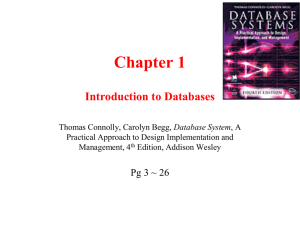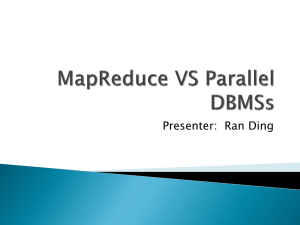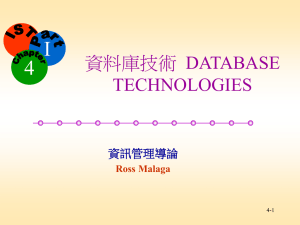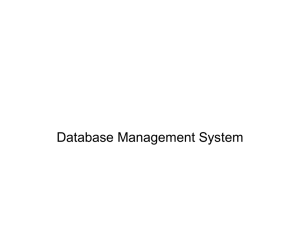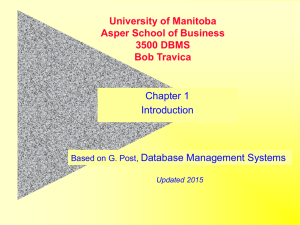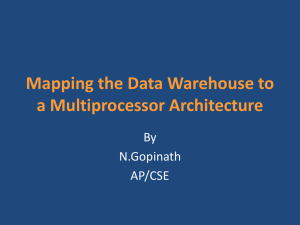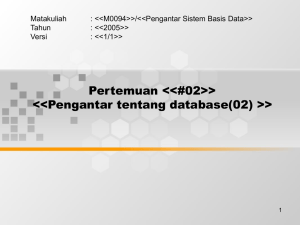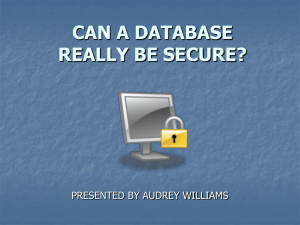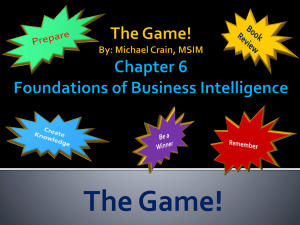LECTURE_ONE_Introduction_to_databases
advertisement
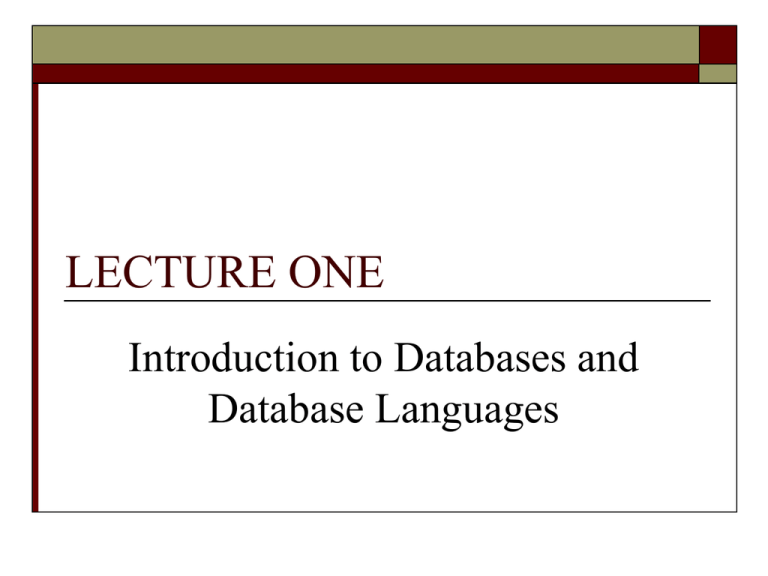
LECTURE ONE Introduction to Databases and Database Languages Preview and objectives Data Vs Information Manual Filing systems File-based systems Database Approach Database Terminologies Components of a DBMS Environment Roles in the Database Environment Data Vs Information Data: Is referred to as facts concerning objects and events that could be recorded and stored on computer media. Information: Is referred to as data that has been processed in such a way as to increase knowledge of the person who uses the data. • Information reveals meaning. • Good, timely, relevant information is a key to decision making. NB: The terms data and information are closely related, and are often used interchangeably. Manual Filing systems A manual file is set up to hold all external and internal correspondence about a given subject e.g. bills, project File based Systems 4 Manual Filing Systems cont’d For easy storage, especially as numbers increased, labels are utilized. These files are kept in cabinets which are locked to ensure security. File based Systems 5 Manual Filing system cont’d It works well when the data or number of items to be stored is small. Works well on a large number of items which only require storage and retrieval. Retrieval of data; is mainly sequential i.e. search begins from first entry or through an indexing system. Limited processing of data i.e. answering complex queries that require data from different sources e.g. annual reports about sales was very difficult. QUIZ: What are the challenges/Limitations of the manual filing system? File based Systems 6 File-based systems File-based systems were the predecessors of databases; a good understanding of these enable one to: Avoid making the same mistakes in databases Easily convert a file-based system to a database system File-based systems were an early attempt to computerize the manual filing system. File-based Systems The file-based systems were introduced to respond to the need for more efficient data access. They may be defined as a collection of application programs that perform services for the end users (e.g. reports). They were set up based on a decentralized approach rather than a centralised one i.e. each department in an organisation had a system to deal with its data. Therefore each program defined and managed its own data. File based Systems 8 File-based Processing File based Systems 9 Limitations of File-based Approach 1. 2. 3. Separation and isolation of data Each program maintains its own set of data. Users of one program may be unaware of potentially useful data held by other programs. Duplication of data Same data is held by different programs. Wasted space and potentially different values and/or different formats for the same item. Requires extensive programming in third generation Is time consuming File based Systems 10 Limitations of File-based Approach 4. Data dependence File structure is defined in the program code. Change in file data’s characteristics requires modification of data access programs. Must tell program what to do and how Makes file systems cumbersome from programming and data management views. 5. Incompatible file formats Programs are written in different languages, and so cannot easily access each others files. File based Systems 11 Limitations of File-based Approach 6. 7. Fixed Queries/Proliferation of application programs Programs are written to satisfy particular functions. Any new requirement needs a new program. Data Redundancy Different and conflicting version of the same data. Results of uncontrolled data redundancy Data anomalies: Modification, Insertion, Deletion Data inconsistence: Lack of data integrity 8. Limited data sharing Database Approach cont. Databases were developed as a solution for the limitations of file based systems for data storage and management. The Essence of a Database Organization of data Efficient retrieval of data Reliable storage of data Maintaining the consistency of the data Sharing data Structuring the data Introduction to Databases 1.13 Database Approach Databases have become and integral part of the day-to-day life e.g. in the business world. Arose because: Definition of data was embedded in application programs, rather than being stored separately and independently. No control over access and manipulation of data beyond that imposed by application programs. Result The database and Database Management System (DBMS). Introduction to Databases 14 Database Terminologies A database can be simply known as an organised collection of related data. Formally may be defined as a shared collection of related data, and a description of the data, designed to meet the information needs of an organisation. A relational DB is a collection of tabular structures that can be related to each other by a common field. Introduction to Databases 1.15 Database Terminologies cont’d A Database Management Systems (DBMS) is software that facilitates the definition, creation, maintenance or and access control to the database. These functionalities are achieved by the support of database languages (e.g. DDL, DML, DCL and TCL) The DDL allows users to define the database, specify the data types and structures and the constraints on the data to be stored in the database. It allows users to insert, update, and retrieve data from the database, usually through a Data Manipulation Language (DML). Introduction to Databases 1.16 Database Terminologies cont’d It has features such as security (preventing unauthorized users from accessing the database), transaction management, backup, and recovery. An example of a DBMS is a relational database management system (RDBMS). Terminology cont’d A database system is a combination of software, data and computer hardware that implements a collection of data models and applications. A database system uses a DBMS together with application programs to create an information system for a specific purpose. Simply put, it’s a DBMS together with the data itself. A database application is a program that interacts with a database at some point in its execution. Components of a DBMS Environment Hardware: The DBMS and applications require hardware to run. The hardware can range from single personal computer, to a single mainframe, to a network computer. The particular hardware depends of the organization’s requirements and the DBMS used. Software: The software component comprises of the DBMS software itself and the application programs together with the operating system including the network software if the DBMS is being used over a network. Typical applications programs are written in third generation languages (3GL) e.g. C, C++, Visual basic, Java etc. Components of a DBMS Environment Data: Perhaps the most important component of DBMS environment certainly from the end- users’ point of view, is the data. Data acts as a bridge between the machine components and the human components. The database contains both the operational data and metadata, the ‘data about data’. The structure of the database is called the schema the schema in turn contains tables and attributes Procedures:Refer to the instructions and rules that govern the design and use of the database. The users of the system and the staff that manage the database require documented procedures on how to use or run the system. Components of a DBMS Environment Procedures may include: Log on to the database; Use of a DBMS facility or application program; Start and Stop of a DBMS; Make backup copies of the database; Handle hardware and software failures which may include procedures on how to identify the failed components, the appropriate hardware engineer and, following the repair of the fault, how to recover the database.Change the structure of the table, recognize the database across multiple disks, improve performance, or achieve data to secondary storage. People: The final component is the people involved with the system Roles in the Database Environment Data Administrator (DA) Database Administrator (DBA) Database Designers (Logical and Physical) Application Programmers End Users (naive and sophisticated) Question: Discuss the different roles carried out by the above people in the database environment? Roles in a Database Environment 22
